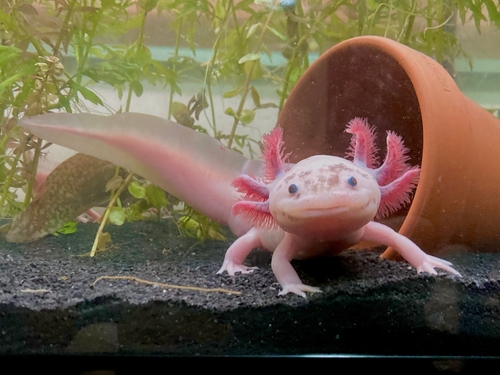Let’s dive into the whimsical world of axolotls, those adorable aquatic enigmas from Mexico that have stolen hearts around the globe. With their forever-young faces and frilly gills, axolotls are more than just a pretty face in the amphibian crowd; they’re a marvel of nature with some pretty neat party tricks up their sleeve.
Now, if you’ve ever wondered just how long these critters can keep the party going, you’re in for a bit of a surprise. Out in the wild, axolotls are somewhat like shooting stars—brilliant but fleeting, with a lifespan that usually caps at around five or six years. But, give them a cozy setup at home, and they turn into long-haul champions, boasting lifespans that can reach a whopping 15 years!
So, what’s the secret to their extended youth? It all boils down to the TLC they receive. Creating the ultimate axolotl pad involves more than just filling a tank with water and calling it a day. These guys thrive in a home that mirrors their natural habitat, with just-right water conditions, including the perfect temperature and pH levels, not to mention a diet that’s as nutritious as it is delicious.
But it doesn’t stop there. Just like any pet, axolotls and baby axolotls need a bit of pampering and attention to keep their spirits high and their health in tip-top shape. Regular health check-ups, a well-maintained tank, and a dash of love and care can make all the difference, turning your axolotl’s home into its own personal fountain of youth.
So, whether you’re an axolotl aficionado or just dipping your toes into their world, remember: a little care goes a long way in keeping these quirky amphibians happy, healthy, and ready to enchant you for years to come.
Contents
Key Takeaways
- Axolotls can live 5-6 years in the wild and up to 15 years in captivity with proper care
- Maintaining optimal water conditions and providing a nutritious diet are crucial for the axolotl lifespan and longevity
- Ensuring these amphibians receive appropriate care in captivity supports their unique biology and promotes overall health
You will also love these other top posts:
Axolotl Lifespan

In the Wild
In their natural habitat, axolotls have a shorter lifespan compared to their captive counterparts. A wild axolotl typically has a lifespan ranging from 5 to 10 years. To survive in their natural habitat, they need a healthy ecosystem that provides plenty of food and clean water.
Unfortunately, these conditions are not always present in the wild, which contributes to their shorter lifespan. Threats such as pollution, habitat degradation, urbanization, and water diversion due to human population growth are major challenges that axolotls face in the wild.
In Captivity
Axolotls in captivity tend to live longer than their wild counterparts. Their lifespan ranges from 10 to 15 years. One key factor contributing to their increased lifespan in captivity is the control over their environment.
Captive axolotls are provided with ideal living conditions that allow them to thrive. Some of these ideal conditions include:
- A 15-20-gallon aquarium
- Water temperature between 60-64 °F (16 -18 °C)
- Water pH level 7.4 – 7.6
- Slightly hard water
By maintaining these optimal conditions, owners can ensure a longer and healthier life for their captive axolotls.
Basics of Axolotl Care
Housing
Axolotls thrive in an aquatic environment and require a suitable habitat to ensure a healthy life. A 10-gallon (38 liter) tank can work for a single axolotl, but opting for the largest tank possible is recommended as it gives the axolotl more room to explore.
Choose a soft substrate, like sand or fine gravel, to prevent injuries to their delicate bodies. This also prevents them from accidentally eating the substrate.
Water Conditions
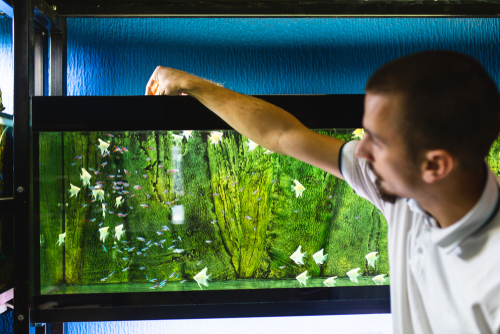
Maintaining water quality is crucial for the wellbeing of your axolotl. The ideal water temperature should be between 60-68°F (15-20°C), and a stable pH level around 7.4 ensures a proper environment.
Be attentive to the water’s cleanliness, and use a filter to remove waste and harmful chemicals. Regular water changes are also essential for axolotl care to keep the aquatic environment in optimal condition.
Diet
A well-balanced diet is crucial for axolotls to maintain their energy and health. They have diverse food preferences, including live or frozen bloodworms, earthworms, and brine shrimp.
Feed axolotls daily or every other day, depending on their size and age. Be observant of their gills, as this can indicate if they are receiving the proper nutrients they need for a long and healthy life. Nutrition is a vital part for an axolotl lifespan.
Axolotl Anatomy

Physical Appearance
The axolotl is an amphibious creature with unique physical features that set it apart from its relatives.
Adult axolotls typically range in size from 15 to 45 cm (6 to 18 inches), with most individuals closer to 23 cm (9 inches). Their unusual appearance includes a head with a wide, flat mouth and round, protruding eyes without moveable eyelids.
Axolotls have a well-developed tail that extends from behind their head all the way to the vent, which is accompanied by a caudal fin. Their unique external gills resemble feathery plumes, which help them breathe underwater.
In addition to their external gills, axolotls have four limbs, each ending in tiny digits for balance and mobility.
Regarding colors, axolotls exhibit various shades, including gray, dark brown, golden, and white. Some individuals display spots and speckles across their bodies, while others have uniform coloration.
Internal Organs
Internally, axolotls possess a set of fully functional lungs, despite their primarily aquatic nature. This allows them to survive in varying water conditions.
Their feathery gills, however, remain their primary method of oxygen exchange, effectively taking in oxygen from the water that surrounds them.
The axolotl’s unique physiology enables it to maintain a larval stage throughout its entire life, a feature not often seen in other amphibians.
This means that, while the axolotl experiences some growth and development, it never truly undergoes a full transformation into an adult form like most amphibians. Even a complete axolotl lifespan will never experience this complete transformation.
Axolotls, like most animals, have a range of internal organs that help with digestion, circulation, and overall health.
Their semi-transparent skin allows for some visualization of internal organs, providing a fascinating glimpse into their internal workings. However, a full understanding of their internal anatomy would require further exploration and research.
Reproduction and Breeding
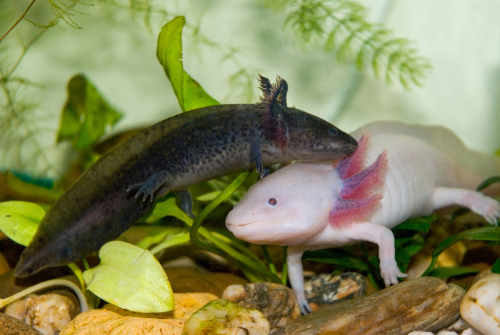
Mating Process
Axolotls reach sexual maturity at around 1.5 years old. The mating process begins with a courtship dance, during which the female nudges the male’s cloaca. The male then deposits cone-shaped sperm packets (up to 12) on the lake bottom. The female follows the male and collects sperm using her cloaca.
Egg Laying and Care
After a few days, the female axolotl will lay her eggs. She can lay hundreds of eggs, which she attaches to underwater vegetation or rocks. The eggs typically hatch within 2-4 weeks, depending on the water temperature.
When the eggs hatch, the young axolotls, called larvae, are about the size of a grain of rice. This is the beginning of an axolotl lifespan. They have gills, a tail, and small limb buds. The larvae will further undergo the process of metamorphosis after a period of six to 12 months.
During metamorphosis, axolotls experience several physical changes as their lungs develop and they lose their gills. Once the metamorphosis is complete, the axolotls transform into adults who can breed. Their bodies won’t change much more during the rest of their axolotl lifespan.
Unique Abilities
Regeneration
Among the axolotl‘s most notable abilities is its capacity for regeneration. This fascinating creature can regenerate a wide range of body organs and lost limbs. In just a few weeks, an axolotl can grow back limbs that have been lost, demonstrating an incredible healing process.
In addition to limbs, axolotls can also regenerate their lungs, heart, spinal cord, and even parts of their brain if they suffer a head injury. Throughout this process, the axolotl remarkably heals without any scarring. They can regenerate during their full axolotl lifespan, but as they age, it can be more difficult for them.
Metamorphosis
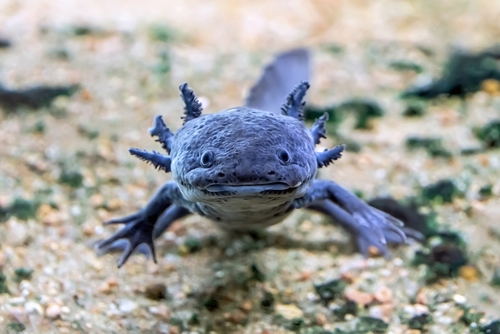
Axolotls, also known as Ambystoma mexicanum, stand out from other salamanders due to their unique approach to metamorphosis. Axolotls exhibit neoteny, which means they retain their juvenile characteristics into adulthood. They will keep their juvenile characteristics all throughout their axolotl lifespan.
This trait sets them apart from other salamanders, as axolotls do not undergo full metamorphosis and remain in their larval stage throughout their lives. Neotenic axolotls keep the external gills and aquatic habits they display during their youth, which can be observed in their life cycle stages. All axolotls will stay in their larval stage for the rest of their axolotl lifespan.
In summary, the axolotl is a remarkable creature with unique abilities such as regeneration and a distinct approach to metamorphosis. Through their ability to regenerate multiple tissues and organs, as well as their retention of juvenile characteristics, axolotls provide valuable insights into the world of amphibians and biological processes.
Diseases and Health Issues
Axolotls are relatively hardy creatures, but they can still face a variety of health issues and diseases at any stage of their axolotl lifespan. The most common diseases that can affect axolotls include blockage and impaction, red leg syndrome, abscesses, and bacterial or fungal infections.
Stress can also lead to diseases in axolotls, with common stressors including high water temperatures (over 24 °C) and powerful water flow from filters. This can occur at any stage of the axolotl lifespan.
Moreover, foul water due to inadequate water changes, sudden temperature changes, and untreated tap water can also cause stress and lead to health issues. Parasites and fellow tank companions, like fish, might create stressful conditions as well.
It is essential to keep an eye on the axolotl’s health and maintain a clean, stable environment to prevent diseases. While larvae, axolotls can be more susceptible to health problems, so providing adequate care and attention during this stage is crucial.
Impaction, which is a blockage of the digestive system caused by ingesting foreign objects or indigestible material, is one of the most common health concerns. To avoid impaction risk, only provide safe, soft, and appropriately sized food and substrate for axolotls.
Threats to Axolotls
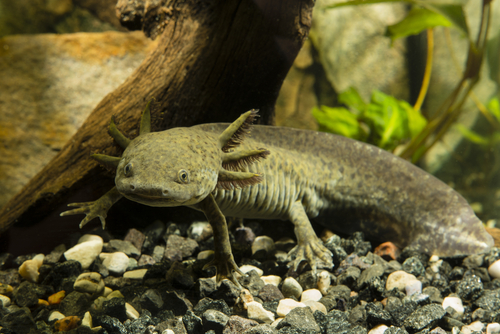
Environmental Factors
Axolotls, a unique type of salamander, face numerous environmental challenges that threaten their survival in the wild. As aquatic creatures, they rely heavily on clean water to maintain their health. This is vital for every part of the axolotl lifespan.
However, pollution from industrial and agricultural sources has severely affected the quality of water in their natural habitat, especially in Lake Xochimilco near Mexico City.
This polluted water leads to increased stress on the axolotls’ bodies, making them more susceptible to diseases and reducing their chances of long-term survival.
Another environmental concern for axolotls is the introduction of invasive species into their habitats. Predators such as fish, aquatic birds, and other larger creatures may prey upon axolotls, depriving them of the opportunity to reach adulthood and reproduce. This is more likely to happen closer to the beginning of the axolotl lifespan because of their small size.
Additionally, invasive plant species can alter the delicate underwater ecosystem, affecting the availability of food and hiding spots for these salamanders.
Endangerment Status
Axolotls are currently listed as critically endangered on the International Union for Conservation of Nature (IUCN) Red List. As a result, their population in the wild has drastically decreased, putting them at risk of extinction. The main factors contributing to their endangerment status include habitat destruction, pollution, and lack of prey by the increasing number of invasive species.
Conservation efforts are being made to stabilize and grow the axolotl population. These efforts include research projects to better understand the biology and ecology of the species, habitat restoration initiatives, and breeding programs aiming to reintroduce axolotls to suitable environments.
However, the success of these efforts depends on the cooperation and support of local communities, governments, and international organizations.
To conclude, axolotls face numerous threats in their natural habitat, leading to their critically endangered status. Environmental factors, such as pollution and invasive species, contribute to the decline in their population.
Efforts to protect and conserve axolotls are essential for the survival of these unique and fascinating salamanders.
The Axolotl’s Place in Nature
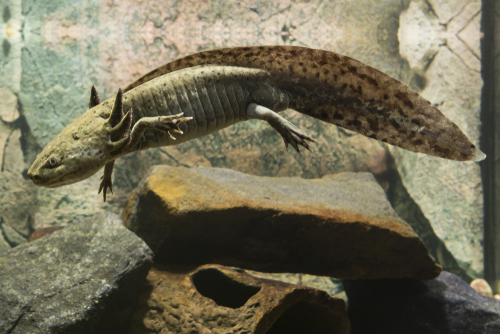
The axolotl, scientifically known as Ambystoma mexicanum, is a unique and fascinating creature that belongs to the amphibian class, specifically the order Urodela among salamanders.
They are often referred to as “Mexican walking fish”, although they are not fish but amphibians. Axolotl is a member of the family Ambystomatidae is native to the Xochimilco and Chalco lake systems located in Mexico.
Unlike most amphibians, axolotls are known for their paedomorphism, meaning they retain their larval features into adulthood. This is true for the whole axolotl lifespan.
This means they keep their external gills and remain aquatic throughout their lives, never undergoing the complete metamorphosis seen in other members of the Ambystomatidae family. This unusual trait makes them a subject of great interest for scientific research. The axolotl lifespan is very unique because of their growth or their lack of.
Axolotls thrive in the freshwater habitats of Lake Xochimilco and were once abundant in Lake Chalco. However, extensive urbanization and habitat degradation have put them on the brink of extinction in the wild. The International Union for Conservation of Nature has classified the axolotl as a critically endangered species since 2006.
As carnivorous amphibians, axolotls feed on a variety of small aquatic organisms, such as insects, worms, and smaller aquatic creatures. They possess impressive regenerative abilities, which allow them to regrow lost limbs and repair other injuries, making them an important model organism for scientific research on tissue regeneration. This ability is possible for the whole axolotl lifespan.
In their natural habitat, axolotls play a vital role in maintaining the balance of their ecosystem.
As predators, they help control the populations of smaller aquatic organisms, while also serving as prey for larger predators, such as birds and fish. This balance is crucial for the health and stability of aquatic ecosystems like Lake Xochimilco.
Unfortunately, axolotl populations have been significantly impacted by pollution, invasive species, and habitat loss, which threaten their long-term survival in the wild.
Conservation efforts are underway to preserve their habitats, control pollution, and monitor their remaining wild populations. In captivity, axolotls are bred for food, sold as pets, and used for scientific research, ensuring the continued existence of these remarkable amphibians.
Frequently Asked Questions
What is a typical axolotl lifespan?
The axolotl lifespan is around 5 to 10 years in the wild and up to 20 years in captivity.
What factors affect the axolotl lifespan?
The axolotl lifespan is influenced by factors such as water quality, temperature, and diet. Ideal tank conditions for axolotls include a water temperature between 60-64 °F (16 -18 °C), water pH level of 7.4 – 7.6, and slightly hard water.
How can I increase my axolotl lifespan longevity?
Maintaining ideal tank conditions can help increase axolotl lifespan. Provide a clean habitat, consistent water temperature, and proper diet to ensure your axolotl is healthy.
Do captive axolotls live longer than wild ones?
Yes, captive axolotls tend to live longer than their wild counterparts. Axolotls in captivity can live for up to 20 years, while wild axolotls have a lifespan of 5 to 10 years. The controlled environment and access to proper care contribute to the longer lifespan of captive axolotls.
What causes a shortened axolotl lifespan?
Factors that can shorten the axolotl lifespan include poor water quality, inadequate temperature control, stress, and improper diet. Ensuring the right living conditions and care can help prevent these issues.
Are there any specific health issues that impact axolotl lifespans?
Axolotls are known for their ability to regenerate damaged limbs, which can contribute to their long lifespan. However, they are critically endangered in the wild, with fewer than 1,000 remaining due to habitat loss and pollution. In captivity, they can still face health issues if their living conditions are not adequately maintained.

Ian Sterling, founder of Fishlab.com, began his aquarium journey over 30 years ago, driven by a deep fascination for fish and their diverse personalities. His website, Fishlab.com, is dedicated to making fishkeeping accessible and enjoyable, offering beginner-friendly guidance, expert insights, and a community for aquarists to connect and share experiences.


